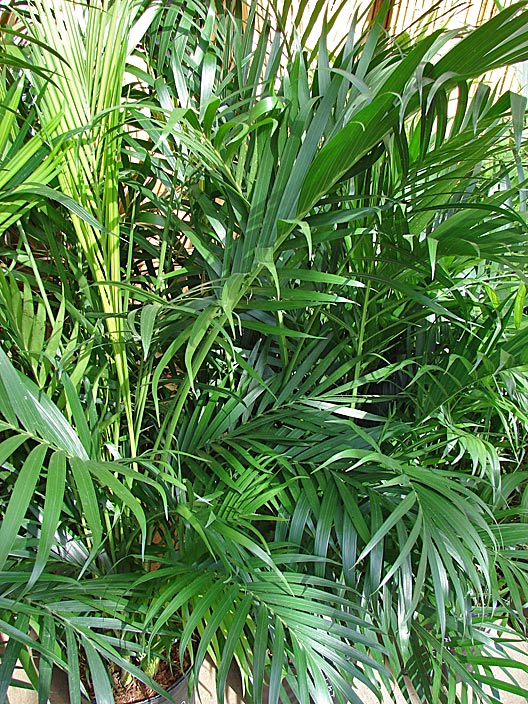Chamaedorea cataractarum
|
Chamaedorea cataractarum habit. Photograph courtesy of Fairchild Tropical Botanical Garden, Guide to Palms http://palmguide.org/index.php |
|
Chamaedorea cataractarum in container (Starr image 080117-2236). Photograph courtesy of Forest & Kim Starr, starrimages@hear.org |
Common name
cat palm, cascade palm
Description
Stems: Clustering, creeping stems, to 2 m tall and up to 4 cm in diameter, branching at the base to form large clumps. Leaves: Pinnatepinnate:
like a feather; palms with pinnate leaves usually have compound leaflets attached to a rachis, although a pinnate leaf may be entire with pinnate veins (e.g., <em>Chamaedorea metallica</em>)
, reduplicatereduplicate:
Most palm leaflets or leaf segments are obviously folded. If the folds create an upside-down V-shape, with the margins lower than the midrib (so that rain might "run off the roof"), the folding is reduplicate.
, to 30 cm long, with linearlinear:
term to describe leaves and leaflets that are narrow with nearly parallel margins; like a line
to lanceolatelanceolate:
term to describe leaves and leaflets that are longer than wide and widest below the mid-point; lance-shaped
leaflets evenly spaced along the rachisrachis:
an extension of the petiole through the blade of a pinnate leaf to which leaflets are attached
, slightly drooping and spreading in a single plane. Upper and lower leaflet surfaces are green, without spines or obvious tomentumtomentum:
a covering of closely matted or fine hairs on plant leaves
. Flowers and fruits: Pendulous, about 0.5 m long, branched to one order with up to 15 branches. Yellowish male and female flowers are borne on different plants. The oblong or ovoid fruits (6-8 mm in diameter and 1 cm long) are black when ripe.
Diagnostic features
Field: Clustering, creeping palms, to 2 m tall with black fruit
Lab: Yellowish midrib and two secondary veins prominent on undersurface of leaflets
May be confused with
Other Chamaedorea species, but few others have a clumping habit. Chamaedorea radicalis is similar, but has longer leaves and the leaflets have no prominent secondary veins. Chamaedorea microspadix has a clumping habit, but red fruit.
Distribution
Native to Mexico, along the Atlantic slope, often growing at stream or river edges
Additional comments
Commonly cultivated in Hawaii and Florida; reported to be naturalized in Hawaii
Scientific name
Chamaedorea cataractarum Mart.
Family
Arecaceae/Palmae
Synonyms
Chamaedorea atrovirens Hort. ex H.Wendl.
Chamaedorea martiana H.Wendl.
Nunnezharria cataractarum (Mart.) Kuntze
Nunnezharria martiana (H.Wendl.) Kuntze
Stachyophorbe cataractarum (Mart.) Klotzsch
Vadia atrovirens (Mart.) O.F.Cook
Vadia jotolana O.F.Cook




